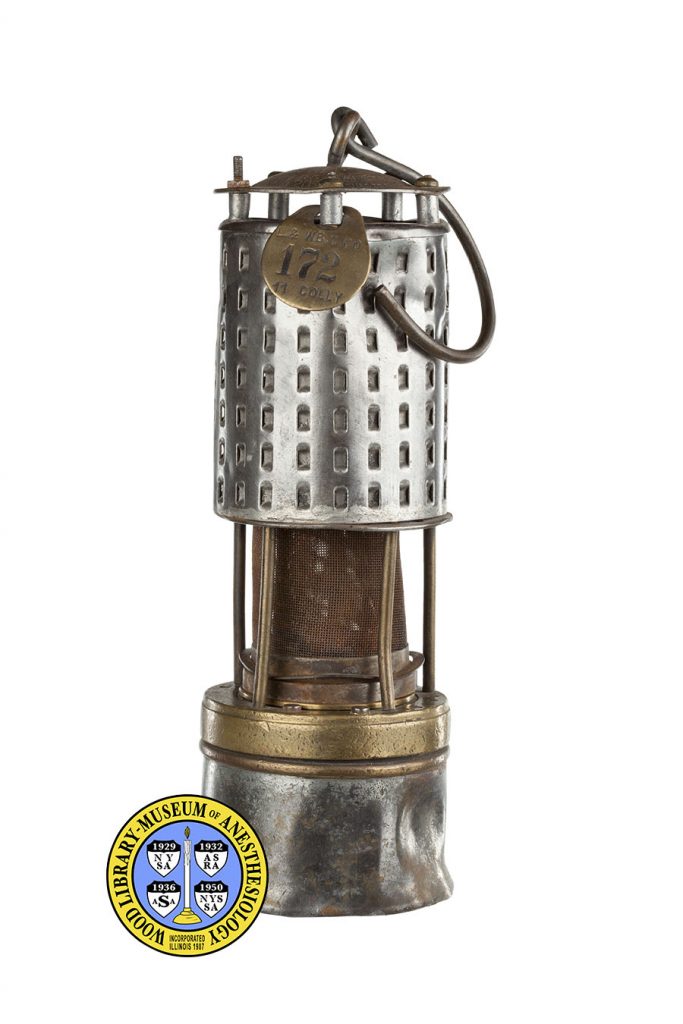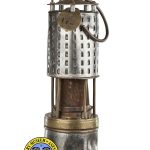Miner’s Safety Lamp
Why would a miner’s safety lamp be in a museum of anesthesiology? Sir Humphry Davy, the chemist who expanded our knowledge of nitrous oxide and first suggested its use to reduce the pain of surgery, also invented a miner’s safety lamp.
“Fire-damp,” a term used for methane gas in a mine, is a colorless and odorless gas that can trigger deadly mine explosions. The design of Davy’s lamp, introduced in 1815, was based on his discovery that a flame surrounded with a thin iron mesh would not ignite gas beyond the mesh, and thus not trigger mine explosions. Other notable inventors of safety lamps included Irishman William Reid Clanny and Englishman George Stephenson.
Manufacturers of flame lamps combined the best design features from the Davy Lamp and others, producing a variety of safety lamps. New designs continued to be introduced into the early 1900s, including this lamp made by the Koehler Manufacturing Company of Marlborough, Massachusetts.
A safety lamp made by Koehler in 1918 was the first miner’s lamp to be approved by the United States Bureau of Mines. The new Koehler lamp was supposed to generate more light than other lamps and produce clearer results when testing the air in a mine. Flames burned higher and with a blue tint when methane was present, while the flame would diminish in the presence of carbon dioxide. Flame-based miners’ safety lamps continued to be manufactured into the 1930s.
Catalog Record: Miner’s Safety Lamp
Access Key: akvt
Accession No.: 2006-10-10-1 D
Title: Permissible miners safety lamp / Koehler Mfg. Co.
Corporate Author: Koehler Manufacturing Company.
Title variation: Alt Title
Title: Brass and steel miner’s safety lamp.
Title variation: Alt Title
Title: Koehler miners’ safety lamp.
Title variation: Alt Title
Title: Koehler miner’s safety lamp.
Title variation: Alt Title
Title: Koehler’s miners safety lamp.
Publisher: [Marlborough, Massachusetts] : Koehler Mfg. Co., [between 1918 and 1940?].
Physical Descript: 1 lamp : metals, including brass and steel ; 28 x 10 x 12.5 cm.
Subject: Davy, Humphry, Sir, 1778-1829.
Subject: Explosions – prevention and control.
Note Type: General
Notes: The early date in the date range for the possible year of manufacture is
based on the date that the Bureau of Mines first approved a Koehler safety
lamp with a round wick like this one, July 29, 1918. If the shield is steel
then the early year is 1918. If the shield is made of aluminum the year would
be 1919, based on the date that the Bureau of Mines approved this design with
an aluminum shield. The marking on the top can not help with the dating as it
appears to have been mis-stamped, “No. 20 A” rather than “No. 201A” or “No.
203A”. The late date is based on the year when electric miners lamps had
generally replaced gas safety lamps.
Note Type: Citation
Notes: Mining lights and hats: safety lamps. National Museum of American History
website. https://americanhistory.si.
edu/collections/object-groups/mining-lights-and-hats?ogmt_page=miners-safety-
amps. Accessed August 20, 2014. [First sentence of the last paragraph:
“Safety lamps were manufactured by a variety of companies from around 1815
until the 1930s, and incorporated elements of their design from Clanny,
Stephenson, and Davy.”]
Note Type: Citation
Notes: Safety Lamps: Including Flame Safety Lamps and Approved Electric Lamps.
Washington, D.C.: Federal Board for Vocational Education; November,
1919:11-16, 30-43. Bulletin No. 42. Trade and Industrial Series No. 12.
https://books.google.
com/books?id=OXE0AQAAMAAJ&printsec=frontcover#v=onepage&q&f=false. Accessed
August 20, 2014. [This work is in approximately the middle a PDF with
multipe works published by the United States Division of Vocation Education.
Bulletin No. 38 on General Mining, Bulletin No. 39 on Coal-Mine Gases, No. 40
on Coal-Mine Timbering, and No. 41 on Coal-Min Ventilation come before No. 42
on Safety Lamps.]
Note Type: Physical Description
Notes: One brass and steel miners’ safety lamp; The measurements in the physical
description field were taken with the hook laying toward the back of the
lamp; The height of the lamp, including hook, when suspended by the hook is
approximately 37 cm; The lamp sits on a circular base, or font, that holds
the illuminant (naphtha or gasoline) and wick; The base has some rusting, and
many dents and scratches; The wick is round; The glass ‘globe’ it is absent;
This lamp as a double metal gauze (both rusted); The upper portion is also
enclosed in a perforated metal shield, or bonnet; The perforations in the
shield have been made on each side of a small pressed rectangle; The top is
pressed or engraved with manufacturer marking around the center, where a ring
for the hook extends; The manufacturer markings include, “PERMISSIBLE [new
line] MINERS SAFETY LAMP [new line] APPROVAL NO. 20 a ISSUED TO THE KOEHLER
MFG. CO.”; The seal of the Bureau of Mines, Department of the Interior is
also stamped on the top; A brass tag marked with “L. & WB. C. CO. [new line]
172 [new line] 11 Colly” is attached to the top of the lamp.
Note Type: Reproduction
Notes: Photographed by Mr. Steve Donisch, September 16, 2013, with a Davy-style
miners safety lamp, SydneyPlus Key akvs.
Note Type: Historical
Notes: Why would a miner’s safety lamp be in a museum of anesthesiology? Sir Humphry
Davy, the chemist who expanded our knowledge of nitrous oxide and first
suggested its use to reduce the pain of surgery also invented a miner’s
safety lamp.
“Fire-damp,” a term used for methane gas in a mine, is a colorless and
odorless gas that can trigger deadly mine explosions. The design of Davy’s
lamp, introduced in 1815, was based on his discovery that a flame surrounded
with a thin iron mesh would not ignite gas beyond the mesh, and thus not
trigger mine explosions. Other notable inventors of safety lamps included
Irishman William Reid Clanny and Englishman George Stephenson.
Manufacturers of flame lamps combined the best design features from the Davy
Lamp and others, producing a variety of safety lamps. New designs continued
to be introduced into the early 1900s, including this lamp made by the
Koehler Manufacturing Company of Marlborough, Massachusetts.
A safety lamp made by Koehler in 1918 was the first miner’s lamp to be
approved by the United States Bureau of Mines. The new Koehler lamp was
supposed to generate more light than other lamps and produce clearer results
when testing the air in a mine. Flames burned higher and with a blue tint
when methane was present, while the flame would diminish in the presence of
carbon dioxide. According to the National Museum of American History flame
based miners’ safety lamps continued to be manufactured into the 1930s.
The brass tag is likely a previous owner’s; The “L. & WB. C. CO.” being an
abbreviation for the Lehigh and Wilkes-Barre Coal Company (L&WB).


